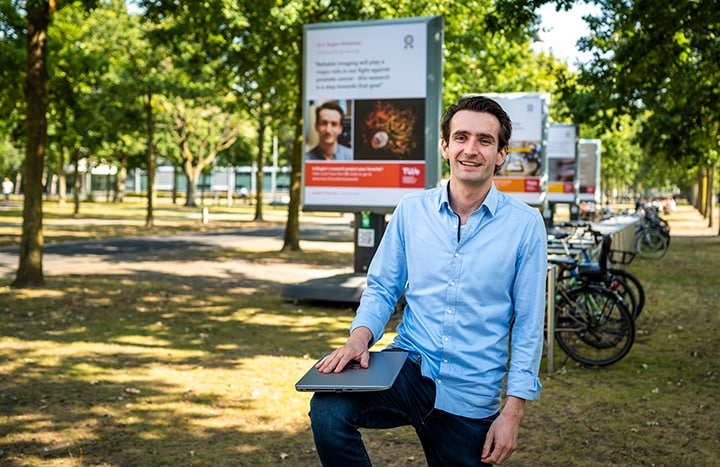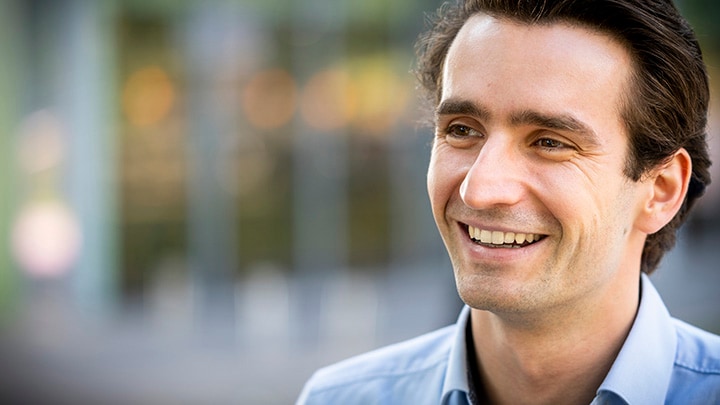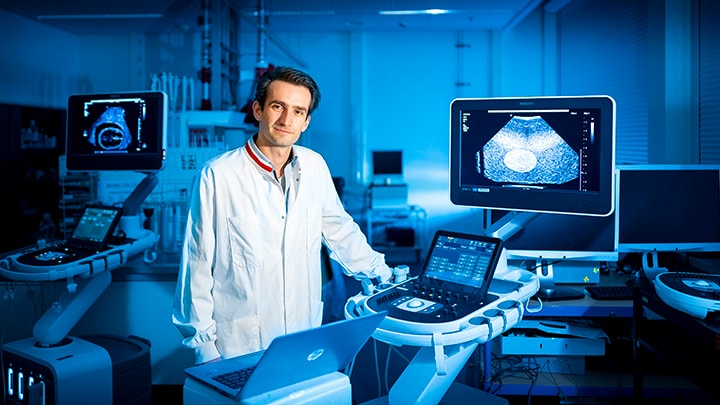Blog
Share on social media
As a scientist I like technology, but technology without application is nothing
Rogier Wildeboer (29) is an enthusiastic young scientist who believes in the power of combination. His PhD research was about combining different ultrasound techniques to detect prostate cancer, using machine learning. He did this under the banner of e/MTIC - a collaboration between PhiFor lips, TU/e and hospitals in the Eindhoven region. At Philips, he's working on innovations to improve the technique for image-based surgery, and he gets the chance to combine two passions: "As a scientist, I love technology very much. But it's even better if you can actually apply that technology in clinical practice, so that people can benefit from it. Technology without application is nothing.
As a scientist, I love technology very much. It is great if you can actually apply that technology in clinical practice, so that people can benefit from it.
Rogier Wildeboer
Scientist
You are both a physicist and a biomedicine practitioner. Was this broad interest in you at an early stage? "I had the academic interest in high school, but I could never choose between biology, chemistry, physics and mathematics. In 5 and 6 VWO I was allowed to take part in a Junior College programme at Utrecht University in which all the beta subjects were covered".

Rogier Wildeboer is nominated for the TU/e Academic Awards 2020 for his PhD thesis How did you end up at TU/e for your PhD research? "Biomedical technology ultimately attracted me the most, because this study is at the intersection of physics engineering and medical science. My final study in Twente was about detecting metastases of breast cancer. I was still in doubt as to whether I would make the move to industry or whether I wanted to obtain a PhD first. Then I saw a list of PhD assignments passing by, including those from Philips and TU/e, and it immediately caught my interest". What was the essence of this research? "Prostate cancer is said to affect almost every man, as long as he gets old enough, even if the form is often not directly life-threatening; 80% of men aged 83 have the disease. When I started my PhD five years ago, every man suspected of developing prostate cancer had to undergo a solid biopsy, and that can be quite painful. Twelve pieces of tissue are then removed for examination. The question that was central to my research was: can we use ultrasound scans to make some of the biopsies unnecessary?
When I started my PhD five years ago, every man suspected of developing prostate cancer had to undergo a solid biopsy, and that can be quite painful.
Rogier Wildeboer
Scientist
What kind of scans were they? "In recent years a lot of research has been done into two imaging techniques: MRI scans and ultrasound. So far there is not a single scan that can replace biopsy, but you can go a long way if you can combine different images. This is also known as multiparametric, because you use different parameters that together can give a good picture."

"One of the techniques I have included in my research is contrast-enhanced echo. My supervisors, Professor Mischi and Professor Wijkstra, have done a lot of research into this. The technique uses small air bubbles that are introduced into the bloodstream. Air bubbles bounced back an awful lot of sound and this technique allows you to visualise the character of blood vessels. This is a valuable application in cancer research because tumours need a certain blood supply in order to develop. Another technique is elastography, in which sound waves are used to see how elastic tissue is. Tumours are often stiff. This is why the technique is sometimes compared to feeling a lump using sound". What was the added value of machine learning in your research? "At the beginning of such a study, I used data from a small patient population. When it appeared that a combination of scans indeed had the potential to better demonstrate prostate cancer, it became important to collect more data to train the model. The more input you put into machine learning, the better the system can learn. With the help of machine learning, we have now developed a model that combines different parameters related to blood vessels or stiffness of tissue to provide a better picture of tumours. However, this needs to be further investigated in the clinic."
The more input you put into machine learning, the better the system can learn. That is why we have now developed a model to provide a better picture of tumours.
Rogier Wildeboer
Scientist
Your PhD research took place under the banner of e/MTIC. What has this collaboration between Philips, the TU/e and regional healthcare institutions done for you? "It is attractive to have the combination of science, industry and clinical practice. e/MTIC has mainly given me the freedom to work with different hospitals, including those outside the region. For example, I have benefited a lot from working with the AMC in Amsterdam, the Jeroen Bosch Hospital in Den Bosch and even a hospital in Hamburg. Within e/MTIC I was often able to get away from my desk and go to hospitals to see how things are going in practice".

After your promotion - which you completed cum laude - you started working at Philips. Was that still obvious, after all these years? "Philips was certainly still a logical choice for me. I am now working on innovations in the field of cardiac catheters. For operations, X-rays are used to take a good look at the body and blood vessels, for example, and also to navigate the devices inside the body. However, X-rays are harmful to the patient and, above all, to the surgical staff. We are therefore working on innovations to reduce exposure to radiation by devising alternative ways for a doctor to look inside the patient's body during surgery. Cardiologists performing cardiac interventions using catheters can see what they are doing; a good example of such an innovation is Philips' KODEX-EPD solution".
We are working on innovations to reduce exposure to radiation by devising alternative ways for a doctor to look inside the patient's body during surgery.
Rogier Wildeboer
Scientist
What is it like to work as a scientist in business? "I had a great time at university. But I also became very curious about how things were going in the business world. Above all, I noticed that you work in a more practical way. In academic research you mainly want to find out whether something works or not and why. At Philips you really work towards the application in practice. As a scientist I really like technology. But it's even better if you can actually apply that technique in clinical practice, so that people can benefit from it. Technology without application is nothing." Every day we are looking for ways to improve life - sometimes in small steps, sometimes in big leaps. Within Philips, many talents are working on technological innovations for care and health. In the Young Innovators series, these innovators have their say; what are they working on? What drives them? What are their ambitions for the future?
